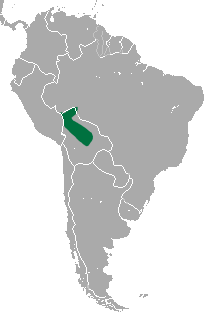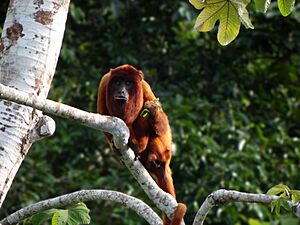Bolivian red howler facts for kids
Quick facts for kids Bolivian red howler |
|
|---|---|
 |
|
| Bolivian red howler at Parque Ambue Ari | |
| Conservation status | |
| Scientific classification | |
| Genus: |
Alouatta
|
| Species: |
sara
|
 |
|
| Bolivian red howler range | |
The Bolivian red howler (Alouatta sara) is a type of howler monkey. These monkeys are a kind of New World monkey and are found only in Bolivia. They live in rain forests, including areas near rivers and forests that flood sometimes.
Contents
Where Bolivian Red Howlers Live
Bolivian red howlers are part of a monkey family called Atelidae. This family also includes spider and woolly monkeys. Red howlers have reddish-orange fur.
You can find red howlers only in parts of South America. This includes countries like Bolivia, Brazil, Colombia, Ecuador, Peru, and Venezuela. They live in tropical forests, especially those near rivers or in areas that get flooded. They can also be found in forests high up, even above 1,000 meters (3,280 feet) above sea level. They prefer to stay in high places.
What Bolivian Red Howlers Look Like
Adult Bolivian red howlers have strong bodies. They can grow quite long. Their tails are very muscular and can grasp branches, helping them swing through trees.
Male howlers are usually about 20.6 to 22.4 inches (52-57 cm) tall. They weigh around 13 to 17 pounds (6-8 kg). Females are a bit smaller. They are about 18.4 to 19.6 inches (47-50 cm) tall and weigh 10 to 14 pounds (4.5-6.5 kg). Both males and females have long arms and legs. Their hands are strong and good at grabbing things.
These monkeys mainly eat leaves. They also enjoy nuts, seeds, fruits, and flowers.
How Bolivian Red Howlers Have Babies
Female red howlers show their tongue to a male if they are interested in mating. If the male isn't interested, she will try another. Mating can happen at any time of the year.
After being pregnant for about six months, the female usually gives birth to one baby. Twins are very rare. Females usually have their first baby when they are about five years old. Males start to mate around two years later.
Newborn howlers are born with fur. They cling to their mother's belly. When they are about one month old, they can start hanging from their mother using their tails. By the time they are one year old, they can ride on their mother's back.
Adult female howlers in the group, especially those without their own baby, often like to cuddle and play with other females' babies. Male howlers are usually affectionate with their own young ones.
How Bolivian Red Howlers Behave
Red howlers live in groups. A group usually has one to three males and two to seven females. Sometimes, groups of single males try to take over a female group by fighting the main male.
Male red howlers are famous for their loud howls. They wake up early and fill the forest with their calls. These howls can be heard up to 2 miles (3.2 km) away! They howl again at night before going to sleep. Other male howlers from different groups answer these calls. This helps them know where other groups are so their territories don't overlap.
Red howlers don't like rain. They will howl in protest when it rains, often hunched over in the trees. They stay high up in the trees to avoid predators like jaguars. If a jaguar comes near, they might throw sticks and branches down at them.
More Facts About Red Howlers
Red howlers can live for about 20 years. Their main predator is the jaguar. There are about six different types of red howlers found in Central and South America. They sleep for about 15 hours every day!
They have the loudest call of any animal in the New World. Even though they spend most of their time in trees, they are good swimmers. Baby howlers drink their mother's milk for 18 to 24 months.
See also
 In Spanish: Mono aullador rojo boliviano para niños
In Spanish: Mono aullador rojo boliviano para niños



